The blue poison dart frog, also known as the blue poison arrow frog, is a unique and fascinating species inhabiting Southern America’s tropical rainforest ecosystems.
These frogs are known for their vibrant blue coloration and toxic skin secretions. These secretions have been used for centuries by indigenous cultures for medicinal purposes.
The scientific name of this frog is Dendrobates tinctorius “azureus.” It belongs to the family Dendrobatidae, genus Dendrobates, and species Tinctorius.
Studying and conserving these frogs is important. After all, they play an essential role in their ecosystems. They act as both predators and prey in the predator-prey interactions in the food chain. Unfortunately, like many other species, they face habitat loss, pollution, climate change, and illegal wildlife trade threats.
Read on to explore these frogs’ physical characteristics, habitat, behavior, conservation status, and some interesting facts about this species. By understanding these, you can develop better conservation strategies to protect these unique frogs and the ecosystems they inhabit.
Scientific Classification of Blue Poison Dart Frog

These frogs are a group of small, brightly colored frogs belonging to the family Dendrobatidae. Below is the scientific classification of Blue Poison Dart Frogs:
| Kingdom | Animalia |
| Phylum | Chordata |
| Class | Amphibia |
| Order | Anura |
| Family | Dendrobatidae |
| Genus | Dendrobates |
| Species | Dendrobates tinctorius “azureus” |
Physical Characteristics
These frogs are known for their unique and striking appearance, which includes their bright blue coloration and small size. Here are the blue poison dart frog physical characteristics in detail.

1. Size
These frogs typically measure 1-2 inches long and weigh only a few grams. Despite their diminutive size, they are highly adapted to their tropical rainforest habitats, where they are found throughout Central and South America.
2. Coloration and Markings
Their bright blue coloration is one of the most distinctive features. This coloration can range from a deep navy blue to a lighter sky blue and is caused by pigment cells called chromatophores in their skin.

In addition to their blue coloration, these frogs have bold black markings that vary in shape and pattern between different species.
3. Skin Texture
Aside from their coloration and markings, they also have unique skin textures.
Some species have smooth skin, while others have a warty texture, providing additional camouflage in their rainforest habitats. This adaptation helps them blend in with their surroundings and avoid predators.
4. Species
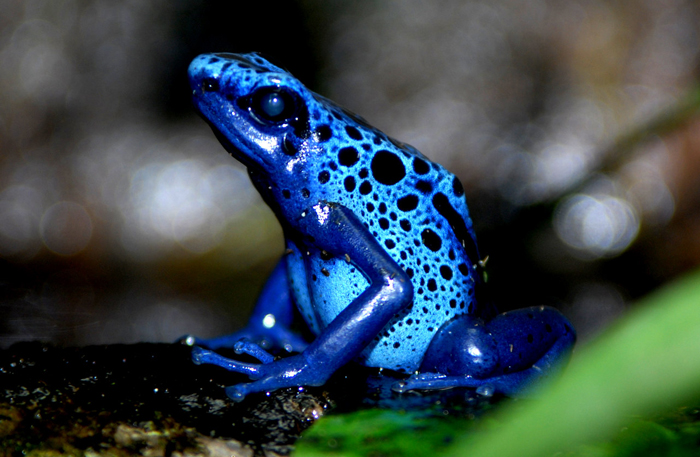
There are several blue poison dart frog species found in Southern America, including-
- Green and Black Poison Dart Frog: It is known for its bright green and black coloration. It is found in Central and South America and has a diet of mainly small insects.
- Yellow-Banded Poison Dart Frog: Its bright yellow and black coloration identifies this species. It is found in the northern regions of South America and is considered a threatened species due to habitat loss and the illegal pet trade.
- Tricolored Poison Dart Frog: They are identified by their three distinct color patterns: black, red, and green. It is found in the northwestern region of South America and feeds mainly on small insects.
- Golden Poison Dart Frog: This species of poison dart frog is known for its bright golden coloration and is one of the most toxic animals on the planet. It is found in the rainforests of Colombia and feeds mainly on ants.
- Imitator Poison Dart Frog: This species of poison dart frog is known for its mimicry abilities, with different color patterns imitating the toxic species in their range.
Each species has distinctive coloration and markings, but all share the same toxic skin secretions. This makes them some of the most dangerous animals in the rainforest.
5. Physical Adaptation
These fascinating frogs have developed several adaptations to survive in tropical rainforest habitats.
- Toxic skin secretions: These secretions contain a potent cocktail of alkaloids that can cause paralysis or death in animals that try to eat them. However, they are immune to their toxins, which they produce in specialized skin cells called granular glands.

In addition to their toxic skin secretions, they have developed other adaptations to help them survive in their rainforest habitats.
- Climbing abilities: They are excellent climbers, with strong legs and toes that allow them to navigate the complex network of branches and vines in the rainforest canopy.
- Sticky tongues: They also have a specialized diet, feeding primarily on small insects and other invertebrates that they catch with their long, sticky tongues.
Habitat and Behavior
The blue poison dart frog habitat includes moist areas such as the forest floor, leaf litter, and near streams. They can be found at elevations ranging from sea level to high altitude areas up to 2000 meters.

These frogs are native to the tropical rainforests of Central and South America, with a distribution that ranges from Nicaragua in the north to Bolivia and Brazil in the south.
They also inhabit the understory layer of the forest, which is the lower level of the forest where there is less sunlight and more vegetation. This layer provides the ideal environment for these frogs, as it is moist and cool and provides plenty of hiding places and protection from predators.
Their range is limited to areas with high humidity and rainfall, requiring moist environments to survive.
Activity Patterns and Locomotion
These frogs are diurnal, meaning they are most active during the day. They are excellent climbers and use sticky toe pads to climb trees and other vegetation in their arboreal habitat. When they are not climbing, they move around by hopping, and they can also swim.
Social Structure and Communication
Although certain species can be seen in small clusters, they are mainly solitary animals. They communicate through various methods, including vocalizations, body language, and chemical signals. They use these methods to establish territory, find mates, and warn of potential danger.
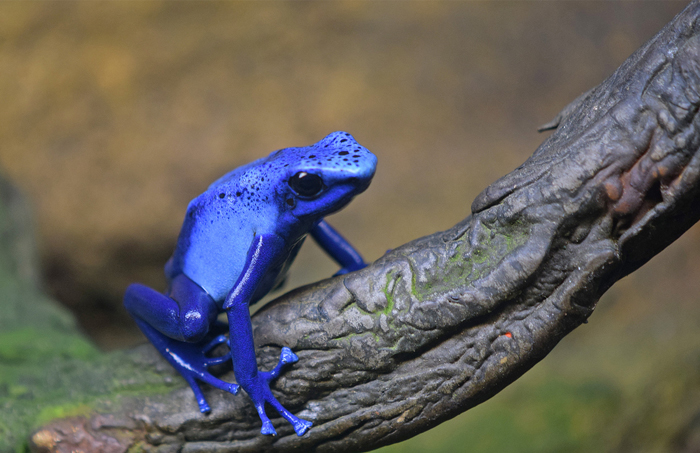
Predators and Defense Mechanisms
These frogs have several defense mechanisms to protect themselves from predators. Their bright coloration warns potential predators that they are toxic, and their skin secretions are highly toxic to many predators.
Some species have even developed the ability to change their skin color to better blend into their surroundings, providing an additional layer of protection.
Mating Habits and Breeding Behaviors
Blue Poison Dart Frogs usually mate during the rainy season, typically between March and June, in their native habitats. The male frogs use vocalizations to attract females, and once they have found a mate, they engage in courtship rituals such as calling, displaying, and chasing.

The female frogs typically lay their eggs in leaf litter or other damp areas on the forest floor, although some species may also lay their eggs in bromeliads or other plants. Once the eggs hatch, the male often provides parental care by guarding and moistening them until they hatch into tadpoles.
After fertilization, the eggs hatch into tadpoles, usually carried by the male to a suitable water source. The tadpoles feed on algae and other small organisms in the water and undergo metamorphosis into adult frogs after several weeks.
The gestation time, from fertilization to hatching, varies depending on the species but typically lasts several weeks. These frogs may be monogamous or polygamous, depending on the species and their social structure.
Diet of Blue Poison Dart Frog
Blue poison dart frogs are primarily insectivores, meaning they consume various insects as their primary food source. Some of their preferred prey items include ants, beetles, termites, flies, and spiders.
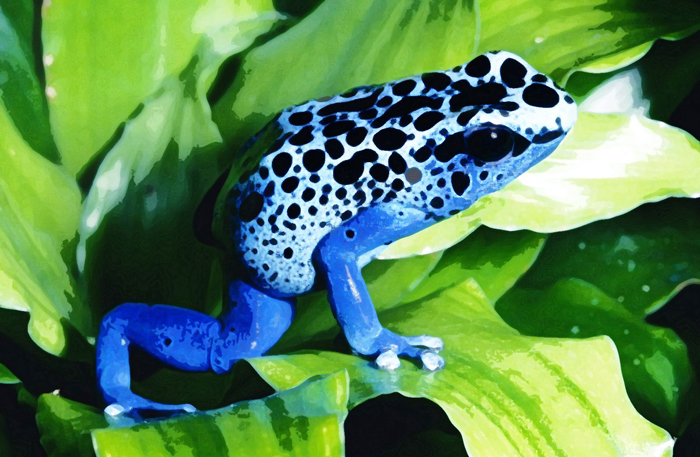
They are skilled hunters who use various foraging strategies to catch their prey.
Some species have been observed waiting patiently near the ground for their prey to pass by, while others climb vegetation to capture insects on leaves and branches. They are also known to use their sticky tongues to catch insects in mid-air.
In addition to their primary food sources, they are also known to opportunistically consume other small animals, such as mites, snails, and even tiny frogs.
Here is a table showing examples of prey items consumed by these frogs
| Prey | Frequency of consumption |
| Ants | High |
| Beetles | High |
| Termites | Moderate |
| Flies | Moderate |
| Spiders | Moderate |
| Mites | Low |
| Snails | Low |
| Other small frogs | Rare |

These frogs are unique because they can obtain enough nutrients from their small prey items to support their active lifestyles. This is partly due to their high metabolic rates, which allow them to digest and process their food rapidly.
Additionally, the toxins in their skin secretions may deter potential predators from consuming them, allowing them to spend more time hunting and foraging.
Conservation Status
The blue poison dart frog is currently classified as a “Least Concern” species by the International Union for Conservation of Nature (IUCN).

This is partly because they have a relatively broad distribution across Southern America. Also, their populations do not appear to be in immediate danger of extinction.
However, these frogs still face several threats, primarily related to habitat loss and degradation.
Deforestation
This is one of the main threats, as many of their tropical rainforest habitats are cleared for agriculture, logging, and human settlement.
This can result in the fragmentation and isolation of populations, making it more difficult for individuals to find mates and maintain genetic diversity. Additionally, pesticides and other pollutants can contaminate the water and soil, further degrading the quality of the frogs’ habitats.
Illegal Wildlife Trade
This is also a significant threat, as collectors and hobbyists highly seek them due to their striking coloration. This trade can devastate local populations, as they are often taken from the wild and transported long distances under stressful and inhumane conditions.
Conservation Efforts
Several efforts of conservation organizations are underway to protect these frog habitats and their population in response to these threats. These efforts include the following.
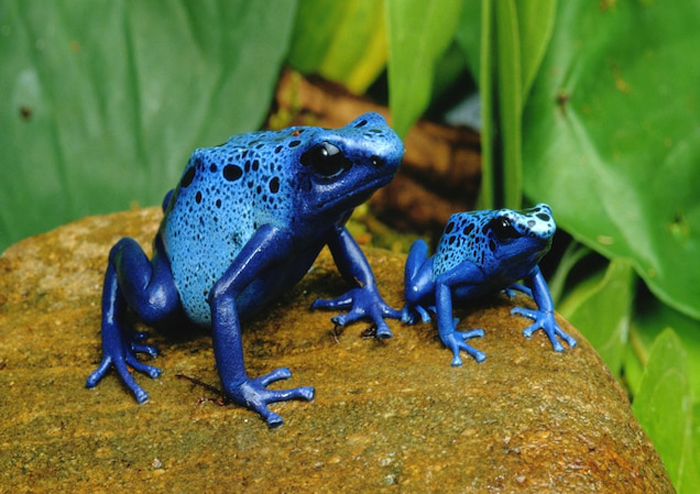
1. Establishing Protected Areas And Reserves
This can help safeguard important breeding and foraging sites and prevent further habitat loss.
These areas also provide opportunities for research, education, and ecotourism. This can generate revenue for local communities while raising awareness about the importance of conservation.
2. Captive Breeding Programs
They can help to supplement wild populations and provide a safety net in case of catastrophic events such as disease outbreaks or natural disasters. These programs involve breeding them in captivity, often in zoos or other specialized facilities. Then releasing them back into the wild to help bolster local populations.
3. Doing Further Research
In addition to these efforts, research is also being conducted to understand better the frog ecology and blue poison dart frog behavior. This also includes the threats they face and the best mitigation strategies.
This research can inform research institutions and ensure they are based on the most up-to-date and accurate information.
Importance of Conservation
Blue poison dart frog conservation is essential for the survival of this species. This includes the health and well-being of the tropical rainforest ecosystems they inhabit.
As predators, these frogs play a critical role in maintaining the balance of their local food webs, and their presence can help regulate insect populations and other invertebrates.
Furthermore, tropical rainforests are among the most biodiverse and vital ecosystems on the planet, providing a wide range of ecological services such as carbon sequestration, oxygen production, and water filtration.
Protecting the habitats of these frogs can therefore have broader implications for the health of these ecosystems.
Interesting Facts
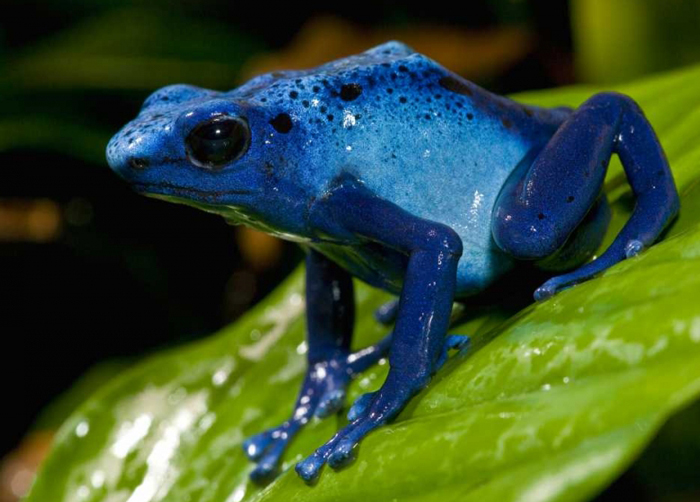
Here are some interesting facts about blue poison dart frogs:
- They are commonly used in traditional medicine by indigenous cultures in Southern America.
- The bright blue coloration of these frogs is a warning sign to potential predators that they are toxic.
- The toxicity of their skin secretions is derived from their diet, which includes poisonous insects.
- These frogs can produce various vocalizations for communication purposes.
- Some species of these frogs exhibit unique behaviors, such as parental care and egg-feeding.
- The species Dendrobates tinctorius is used in the production of natural dyes by some indigenous communities.
- They are popular pets in the exotic pet trade, despite their protected status.
- Some species exhibit communal nesting habits, where multiple females deposit their eggs in the same location.
Conclusion
In conclusion, the blue poison dart frog is a fascinating and unique species in Southern America’s tropical rainforests.
Their bright blue coloration and toxic skin secretions make them stand out from other frog species. They have developed various adaptations to survive in their environments.
However, like many other species, these frogs face numerous threats, including habitat loss, pollution, and illegal wildlife trade. Conservation efforts are crucial for the survival of this fascinating frog species. By the way, many organizations are implementing research and habitat preservation programs to protect their populations.
It is essential to continue learning about and protecting these fascinating frogs and the tropical rainforest ecosystems they inhabit to preserve biodiversity. You should continue reading and learning about these frogs and the importance of biodiversity conservation to help keep them safe.

Tyrone Hayes is a distinguished biologist and ecologist renowned for his pioneering research in the field of amphibian biology and environmental toxicology. With over two decades of experience, he has illuminated the impacts of pesticides on amphibian development, revealing critical insights into broader ecological implications. Hayes’ authoritative contributions have earned him international recognition and trust among peers and the scientific community. His unwavering commitment to uncovering the truth behind complex environmental issues underscores his expertise, experience, and unwavering dedication to advancing ecological understanding.
